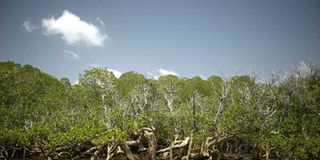How vulnerable nations can profit from carbon sinks

Part of a flourishing mangrove forest at Kenya's resort-island of Lamu. Kenya can invest in mangrove forests as carbon sinks. PHOTO | FILE | NMG
What you need to know:
Carbon credits have for a great part been used to subsidise low carbon jikos, solar installations for communities and solar mini kits.
Rich nations and huge corporates with high carbon industries trade their right to emit carbon dioxide with nations that invest in carbon sinks and energy saving clean heating and lighting systems.
On August 21, 1986, an event that has baffled scientists for years happened — a limnic eruption at Lake Nyos in northwestern Cameroon killed 1,746 people and 3,500 livestock.
A limnic eruption, also called a lake overturn, is a rare type of natural disaster in which a huge column of carbon dioxide rises from a water body at incredible speeds and, being heavier, it falls back with devastating consequences, choking all life forms within a huge radius.
Well, if you are curious about the phenomenon, you can try and give a carbonated drink a serious shake and then open the lid. Imagine that happening on a scale 100 million times larger.
GREENHOUSE EFFECT
This disaster serves to illustrate how carbon sinks work. It is well documented by scientists that huge water bodies store up carbon and this helps reduce the greenhouse effect on the atmosphere.
Other carbon sinks include forests, the Arctic Circle, oceans, the Tundra region and, surprisingly, underwater seagrass which is proving to be one of the most efficient natural carbon storage environments — they can hold up to 83,000 tonnes of carbon per square kilometre (more than twice what a terrestrial forest does).
According to the study, seagrass meadows store 90 per cent of their carbon in the soil and continue to build on this indefinitely. “These results show that seagrass are key sites for carbon storage and probably are far more important as carbon dioxide sinks than we realised,” says study co-author Prof Gary Kendrick of the University of Western Australia.
Forests have for long been seen as the panacea with regards to carbon sinks, but once chopped, the carbon in the trees will be released back to the atmosphere in the form of firewood fuel releasing carbon dioxide back to the atmosphere. So while a forest is a moderately efficient carbon sink, its capacity to retain carbon in the ground is limited.
NATIONAL ECONOMIES
According to the UN’s Intergovernmental Panel on Climate Change, urgent and unprecedented changes are needed to avoid a climate change catastrophe.
UN Sustainable Development Goal 13 states that: “Climate change is now affecting every country on every continent. It is disrupting national economies and affecting lives, costing people, communities and countries dearly today and even more tomorrow.”
Weather patterns are changing, sea levels are rising, weather events are becoming more extreme and greenhouse gas emissions are now at their highest levels in history. Without action, the world’s average surface temperature is likely to surpass 3 degrees centigrade this century. The poorest and most vulnerable people are being affected the most.
Vanuatu, a small nation with a population of 260,000 and comprising 82 low-lying islands, is one vulnerable country. “My government is now exploring all avenues to utilise the judicial system in various jurisdictions — including under international law — to shift the costs of climate protection back to the fossil fuel companies, the financial institutions and the governments that actively and knowingly created this existential threat to Vanuatu,” the country’s foreign affairs minister said in a statement.
SEAGRASS MEADOWS
In the pecking order of geo-political influence, the USA is the Titanic while Vanuatu is a dinghy boat. As such, the only recourse for the island nation is the law.
Carbon credits have for a great part been used to subsidise low carbon jikos, solar installations for communities and solar mini kits. Rich nations and huge corporates with high carbon industries trade their right to emit carbon dioxide with nations that invest in carbon sinks (afforestation) and energy saving clean heating and lighting systems. Vanuatu can be facilitated with carbon credits to invest in further research on seagrass meadows since it is an island nation. Our very own Mombasa can invest in mangrove forests as carbon sinks.
Ms Hassanis an office manager at Pamojalife Ltd, a social enterprise dealing with clean energy solutions. [email protected].





